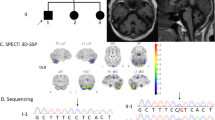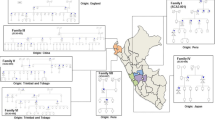Abstract
A recent report (Vermeer et al. in Am J Hum Genet 87:813–819, 2010) implicated for the first time the ANO10 gene in the genetic basis of autosomal recessive cerebellar ataxias. One of the three described families were Roma/Gypsies from Serbia, where the affected individuals were homozygous for the truncating p.Leu384fs mutation and displayed distinct phenotypic features (Vermeer et al. in Am J Hum Genet 87:813–819, 2010). Based on the history and population genetics of the Roma/Gypsies, we hypothesised that p.Leu384fs could be another founder mutation in this population, whose identification in a larger number of genetically homogeneous patients will contribute to defining the phenotypic spectrum of the disorder. Here, we describe additional patients from neighbouring Bulgaria, outlining invariable ANO10-ataxia features and confirming global intellectual decline as part of the phenotype resulting from complete Anactomin 10 deficit.


Similar content being viewed by others
References
Vermeer S, Hoischen A, Meijer RP, Gilissen C, Neveling K, Wieskamp N, de Brouwer A, Koenig M, Anheim M, Assoum M, Drouot N, Todorovic S, Milic-Rasic V, Lochmuller H, Stevanin G, Goizet C, David A, Durr A, Brice A, Kremer B, van de Warrenburg BP, Schijvenaars MM, Heister A, Kwint M, Arts P, van der Wijst J, Veltman J, Kamsteeg EJ, Scheffer H, Knoers N (2010) Targeted next-generation sequencing of a 12.5 Mb homozygous region reveals ANO10 mutations in patients with autosomal-recessive cerebellar ataxia. Am J Hum Genet 87(6):813–819. doi:10.1016/j.ajhg.2010.10.015 (S0002-9297(10)00531-8 [pii])
Harding AE (1983) Classification of the hereditary ataxias and paraplegias. Lancet 1(8334):1151–1155 (S0140-6736(83)92879-9 [pii])
Finsterer J (2009) Ataxias with autosomal, X-chromosomal or maternal inheritance. Can J Neurol Sci 36(4):409–428
H’Mida-Ben Brahim D, M’Zahem A, Assoum M, Bouhlal Y, Fattori F, Anheim M, Ali-Pacha L, Ferrat F, Chaouch M, Lagier-Tourenne C, Drouot N, Thibaut C, Benhassine T, Sifi Y, Stoppa-Lyonnet D, N’Guyen K, Poujet J, Hamri A, Hentati F, Amouri R, Santorelli FM, Tazir M, Koenig M (2011) Molecular diagnosis of known recessive ataxias by homozygosity mapping with SNP arrays. J Neurol 258(1):56–67. doi:10.1007/s00415-010-5682-5
Kalaydjieva L, Morar B, Chaix R, Tang H (2005) A newly discovered founder population: the Roma/Gypsies. Bioessays 27(10):1084–1094. doi:10.1002/bies.20287
Mihaylova V, Hantke J, Sinigerska I, Cherninkova S, Raicheva M, Bouwer S, Tincheva R, Khuyomdziev D, Bertranpetit J, Chandler D, Angelicheva D, Kremensky I, Seeman P, Tournev I, Kalaydjieva L (2007) Highly variable neural involvement in sphingomyelinase-deficient Niemann-Pick disease caused by an ancestral Gypsy mutation. Brain 130(Pt 4):1050–1061. doi:10.1093/brain/awm026 (awm026 [pii])
Gresham D, Morar B, Underhill PA, Passarino G, Lin AA, Wise C, Angelicheva D, Calafell F, Oefner PJ, Shen P, Tournev I, de Pablo R, Kucinskas V, Perez-Lezaun A, Marushiakova E, Popov V, Kalaydjieva L (2001) Origins and divergence of the Roma (gypsies). Am J Hum Genet 69(6):1314–1331. doi:10.1086/324681 (S0002-9297(07)61261-0 [pii])
Morar B, Gresham D, Angelicheva D, Tournev I, Gooding R, Guergueltcheva V, Schmidt C, Abicht A, Lochmuller H, Tordai A, Kalmar L, Nagy M, Karcagi V, Jeanpierre M, Herczegfalvi A, Beeson D, Venkataraman V, Warwick Carter K, Reeve J, de Pablo R, Kucinskas V, Kalaydjieva L (2004) Mutation history of the roma/gypsies. Am J Hum Genet 75(4):596–609. doi:10.1086/424759 (S0002-9297(07)62711-6 [pii])
Alusi SH, Worthington J, Glickman S, Bain PG (2001) A study of tremor in multiple sclerosis. Brain 124(Pt 4):720–730
Lezak M (1995) Neuropsychological assessment. Oxford University Press, New York
Bellebaum C, Daum I (2007) Cerebellar involvement in executive control. Cerebellum 6(3):184–192. doi:10.1080/14734220601169707 (771178752 [pii])
Laforce R Jr, Buteau JP, Bouchard JP, Rouleau GA, Bouchard RW, Dupre N (2010) Cognitive impairment in ARCA-1, a newly discovered pure cerebellar ataxia syndrome. Cerebellum 9(3):443–453. doi:10.1007/s12311-010-0184-7
Middleton FA, Strick PL (1994) Anatomical evidence for cerebellar and basal ganglia involvement in higher cognitive function. Science 266(5184):458–461
Acknowledgments
We thank the family members and controls participating in this study.
Conflict of interest
The authors declare that they have no conflict of interest.
Author information
Authors and Affiliations
Corresponding author
Additional information
T. Chamova, L. Florez, L. Kalaydjieva and I. Tournev have equal contributions to the work.
Electronic supplementary material
Below is the link to the electronic supplementary material.
Rights and permissions
About this article
Cite this article
Chamova, T., Florez, L., Guergueltcheva, V. et al. ANO10 c.1150_1151del is a founder mutation causing autosomal recessive cerebellar ataxia in Roma/Gypsies. J Neurol 259, 906–911 (2012). https://doi.org/10.1007/s00415-011-6276-6
Received:
Revised:
Accepted:
Published:
Issue Date:
DOI: https://doi.org/10.1007/s00415-011-6276-6




